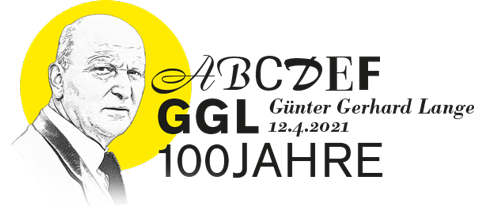Education is a hotly debated topic in Germany. Our correspondent Herbert Lechner talked to Günter Gerhard Lange about the situation in the field of design.
You have devoted your entire career not only to type, type design and development, but also to passing on that typographical knowledge to the next generation. You still teach in Munich and Vienna. What lies behind your involvement in education?
I simply want to pass on the knowledge and experience that I have gathered. Always at the back of your head is the thought that things could be done better somehow.
And can things be done differently?
Yes. We all have latent talent. Discovering that talent is my job as a teacher. Young people who are written off for getting bad marks at school, etc., who are told they are no good, and who then leave school, throw it all in. That’s rock bottom, and that’s where we start. But not right from the start. I tell them “We will start at the place where you are. Everything you now do will be observed by me) and I’ll help you when you get stuck.”
Doesn’t that mean people are too quickly satisfiedwith their first design?
Not at all. We all have our doubts, and that’s a good thing. Finding and throwing out must work together. Sometimes a great idea lands in the waste-paper basket. But that’s ok, it’s all part of the process. Criteria and facts are part of decision-making ability. But that can also lead to uncontrollable results, which go against the direction in which the lecturer is guiding the student. Not if that teacher has international experience. Teachers have to be forced to explain their ideas and their repertoire in a plausible way. You can do everything, but you have to be ready to put forward the proof of the better solution.
Do lecturers offer finished solutions too quickly?
They should be able to justify themselves at international level. Every teacher has to discover and work on the capabilities of the student, and not look for his own self-fulfilment. As a lecturer you have to be able to forget yourself, and simply concentrate on the job in question, of achieving the best in every situation.
Where do you see the failings of education nowadays?
There is a general lack of close international contact between schools and teachers. Of course national characteristics should be preserved, but on the basis of international experience — otherwise there is the danger of a new nationalism developing. What we need are international partnerships between the subject areas. For the benefit of the students, but also for the teachers!
That sounds like criticism of the educators …
There is simply a lack of knowledgeable teachers. As I see it, there is a need to continually »reschool« teachers. Often all the old stuff is simply repeated, and the younger generation just isn’t interested in that!
And what about the level of knowledge of the teaching staff?
They know frighteningly little. Art, history, music, ballet — even famous names … What in other areas is regarded as general knowledge and part of everyday life, is simply lacking, for the most part. What do they learn at school, I’d like to know?
What is your own recipe for success?
I prepare my lectures thoroughly, using my slide collection. I work on them as if I myself were going to be sitting in listening. I try to make them accessible to everyone, whether through photography, painting, typography or architecture. I use any way possible to make sure the message gets across. You have to set up links between things, to suit the target groups — conservative and progressive, word and pictures, alternating, so that they become understandable. For me, for example, all of art history is the history of design. Then people say, »Mr Lange, why are you going to so much trouble?« My answer to that is it’s also fun. Quality of life starts by identifying oneself with one›s work. Then you’ll enjoy it. That’s what I want to get across, too — the students see that their work can bring them satisfaction and self-affirmation.
Would you say that in typography education in particular, where much is so vague because of the computer, that knowledge about the fundamentals is lost? Wouldn’t it sometimes be sensible to get students to work with lead type and letterpress printing, so that they actually experience what type and print is all about?
In colleges abroad that is a firm part of the course in the first term. Anyone getting involved in type design should at least have a firm grounding in the letters themselves — their proportions and developments. They should »experience« metal type and know what it is. But only for information and historical reasons, in the interests of having a really solid foundation. The rest is a matter of form and shape. And that can come about in a variety of ways. As Wolfgang Weingart in Basel once said: The computer is simply an extension of the drawing pencil. All you then need is a rough sketch of the layout to avoid any tapping around in the dark. Contemporary technology offers a wide range of programs which when used properly give sufficient scope for originality.


